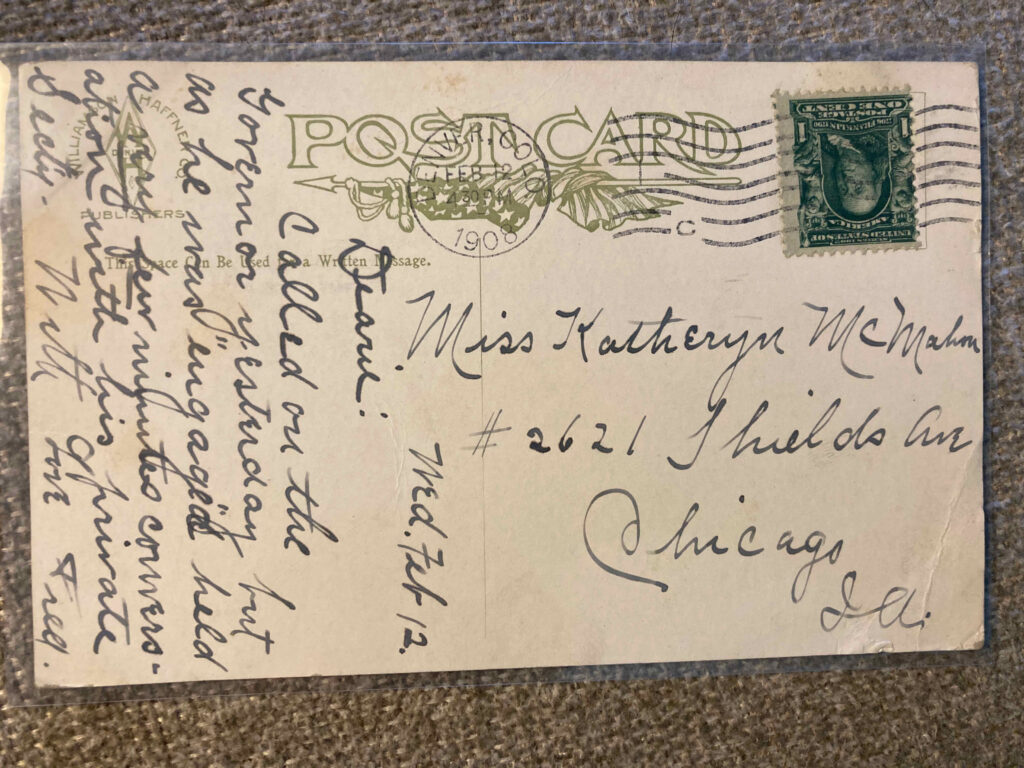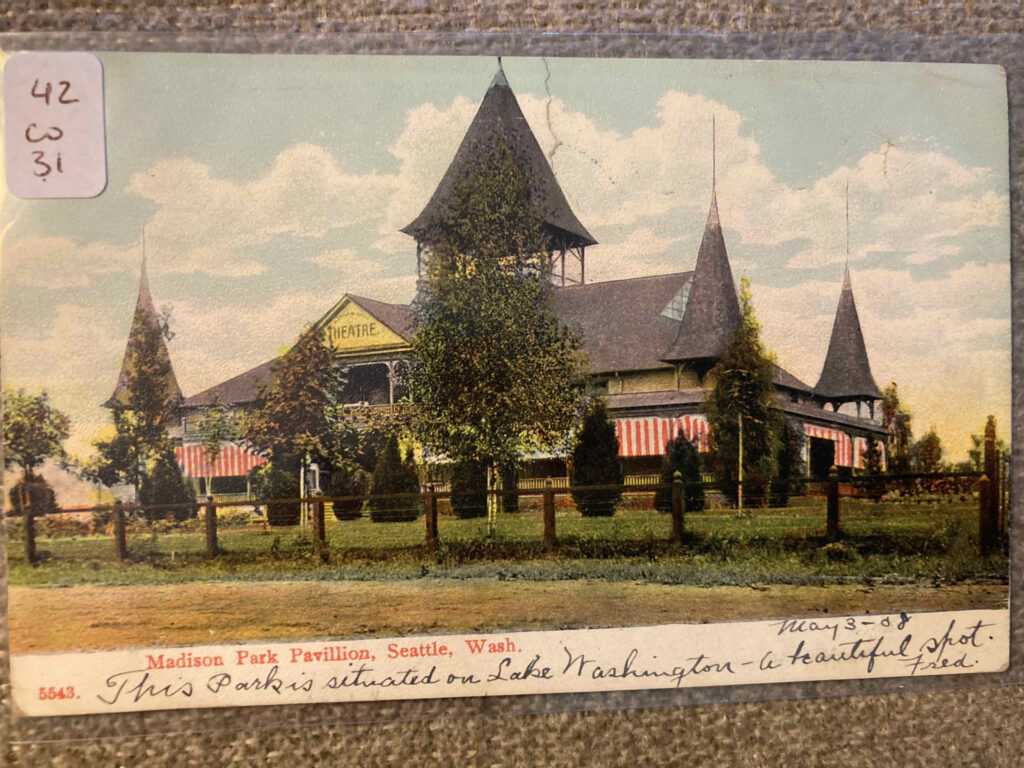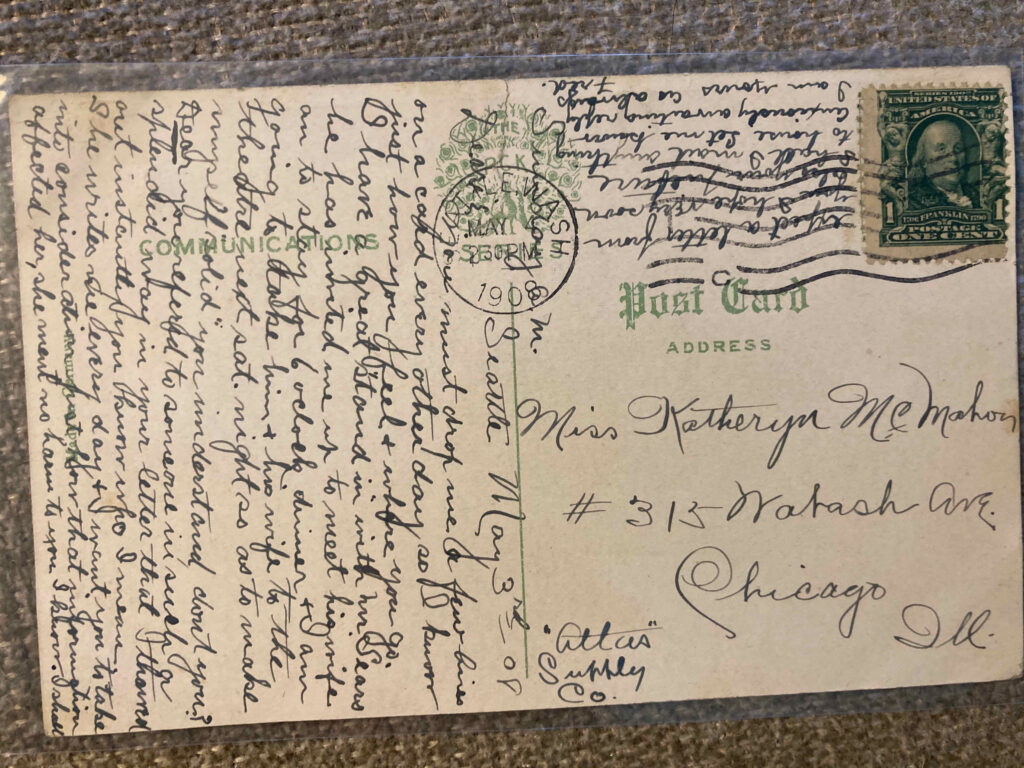From the Governor’s Private Secretary to Writing Everyday
Katheryn McMahon Newton Album, cards 30-31
Evidently, Fred decided to call on the Governor of Colorado, Henry Augustus Buchtel, while passing through Denver. I still don’t know enough about him to find him in the Census–and I’m not (yet) going to start other research to find him in Seattle and/or Chicago records and related materials. The population of Colorado at the time was numbered in the high hundred-thousands; that of Denver in the low hundred-thousands. Fred’s evident comfort level in making the call suggests he came from higher up the class ranks–even though he settled for “a very few minutes” with the Governor’s private secretary.
To continue the discussion of postcard inscription length from last time, what’s typical? I don’t know yet. I can speak to what I’ve seen in the cards I’ve processed, and the other cards I own but have yet to process (however, I’ve glanced over most of them). Let’s leave aside unused cards. They may well be the majority of cards from the time, particularly given collecting fevers, but they fall into a different category.
Here is a very rough initial divide:
- “The card is the message” — i.e. there’s no inscription, only the recipient’s name with or without address (depending on whether it was mailed or hand-delivered). This can be subdivided into cards without any indication as to the sender and those with the sender’s name and/or initials.
- Notification — typically one line or less. An example would be the news that a customer’s order (for fertilizer, for example) is ready or birthday or holiday greetings.
- Short message — Fred’s card above is an example – not particularly long, but more complicated than simple notification. The line between notification and short message can be blurry, and it might be simpler to divide these as into semi-standard short messages (i.e. the text is relatively predictable such as “Happy Birthday!”) and non-standard short messages where the content is not easily predictable (at least by our modern standards). This is something I’ll have to spend more time considering.
- Medium messages — basically, longer than short. Contain more ideas, not necessarily related to each other.
- Long messages — what the name says. These are the ones where the sender verges on filling as much of the card as they can.
Of course, these categories are separate from the discussion in the last post about interaction/influence of the image and message or lack thereof. It’s wonderfully complicated–and it’s quite possible I’ll change my mind about what ways are most helpful to organize and categorize.
On to the next card from Fred, a long one with an interesting circumlocution. The front is simple enough, a place he’s been based on his endorsement as “a beautiful spot.”
Unlike the first card above, in this case I’ll share my transcription of the main message:
“Dearie: You must drop me a few lines on a card every other day so I know just how you feel + where you go. I have a great “stand in” with Mr Sears he has invited me up to meet his wife am to stay for 6 oclock dinner + am going to take him + his wife to the theatre next sat. night so as to make myself “solid” you understand, don’t you? Dear you refered to someone in such a splendid way in your letter that I [thawed?] out instantly you know who I mean. She writes me every day + want you to take into consideration just how that information affected her, she ment no harm to you I know. I shall expect a letter from you I hope very soon also your picture Shall I mail anything to house Let me know anxiously waiting reply I am yours as always Fred”
Fred Newton to Katheryn McMahon, 3 May 1908
Fred addresses several matters here. He continues to encourage her to write more often. Reading between the lines, as we must since we don’t have any of her side of the correspondence so far (likely at all), she’s nowhere near the correspondent he is. I think most people weren’t! He mentions the issue at the start and towards the end, so it’s weighing on him to some degree. Plus he wants a picture of her, a photo or photo postcard. As I recall, he’s mentioned that before and may again.
Then there’s the issue of Mr. Sears. He’s evidently a man of some importance business-wise to Fred. No references have yet provided enough information to identify him, but Fred gives us additional details about their evolving connection. It will be interesting to place these in chronological order when the cards are completely processed. (As a side note, I decided to process them in album order because it’s easier and doesn’t require the investment of time necessary to put them in chronological order, but I admit I’ve been tempted to reconsider.)
Last but not least are the two matters requiring interpretation on one or both ends of the correspondence. First, Fred wants Katheryn to understand why he’s taking Mr. and Mrs. Sears to dinner and the theatre. This apparently falls into a different category than Fred reporting going to the vaudeville. Other cards may provide further information.
For the second matter of interpretation, there’s someone both Katheryn and Fred are at pains not to name or describe explicitly–someone who writes to Fred on a daily basis when Katheryn presumably does not. My gut suggests the unnamed person may be Fred’s mother, Katheryn’s future mother-in-law, but time will tell whether any additional information is uncovered that connects to this.
It is worth noting that this particular card Fred addressed to Katheryn at work, rather than at home.
Tune in next post (Monday) for more on Fred’s expectations (desires) for communications from Katheryn–and how he expects her to keep up with his perambulations!
“From the Governor’s Private Secretary to Writing Everyday,” copyright 2021, A.R. Henle.



